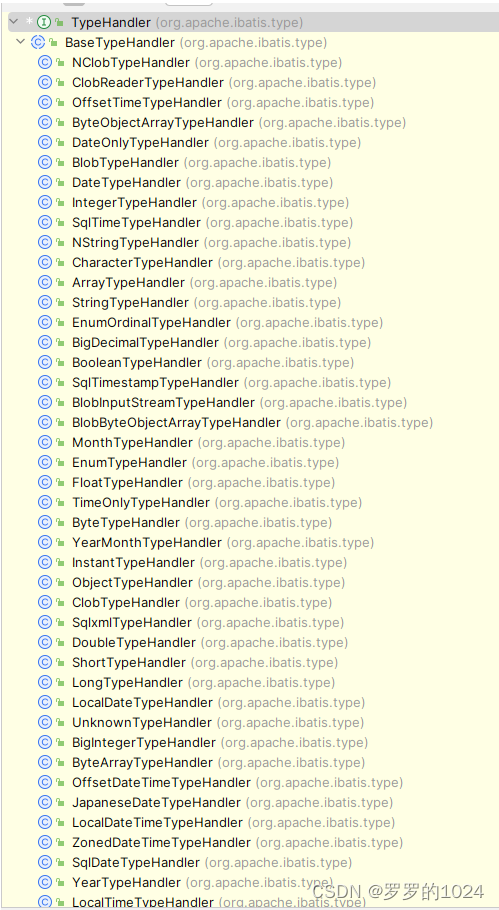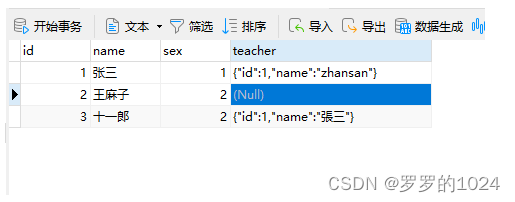热门标签
热门文章
- 1【信息】宁波企业计算机相关岗位春招及感想_宁波工业互联网加班多吗
- 2自用YOLO关键点检测之labelme2yolo格式改变
- 3在谷歌浏览器安装json格式化插件_谷歌浏览器 devtools中直接格式化json的插件
- 4LeetCode题5:用两个栈实现队列(Java实现)_两个栈实现队列javaleetcode
- 5毕业设计:基于深度学习的农作物病虫害识别系统 深度卷积 人工智能 机器视觉_基于深度学习的病虫害检测研究
- 6基于BERT的中文文本分类:将Bert预训练模型进行微调以应用于中文文本分类_中文 bert
- 7论文AI高风险怎么降?用更高级的AI_论文高风险怎么办
- 8python爬虫之redis安装及使用示例_python安装redis库
- 9python贪吃蛇设计思路_Python制作AI贪吃蛇,很多很多细节、思路都写下来了!
- 10linux exit命令_linux中exit命令
当前位置: article > 正文
Mybatis--TypeHandler使用手册_wrapper 查询中的 typehandler 使用
作者:你好赵伟 | 2024-06-07 01:15:50
赞
踩
wrapper 查询中的 typehandler 使用
TypeHandler使用手册
场景:想保存user时 teacher自动转String ,不想每次保存都要手动去转String;从DB查询出来时,也要自动帮我们转换成Java对象 Teacher
@Data
public class User {
private Integer id;
private String name;
private Integer sex;
//这里直接使用数据库无法识别的自定义类型
private Teacher teacher;
}
- 1
- 2
- 3
- 4
- 5
- 6
- 7
- 8
- 9
- 10
- 11
- 12
当然Mybatis给我们提供了接口 TypeHandler(类型映射)
public interface TypeHandler<T> {
//参数转换
void setParameter(PreparedStatement ps, int i, T parameter, JdbcType jdbcType) throws SQLException;
//列值转换
T getResult(ResultSet rs, String columnName) throws SQLException;
//列值转换
T getResult(ResultSet rs, int columnIndex) throws SQLException;
//列值转换
T getResult(CallableStatement cs, int columnIndex) throws SQLException;
}
- 1
- 2
- 3
- 4
- 5
- 6
- 7
- 8
- 9
- 10
看看mybatis内置的类型处理器,这就是为什么一些Java的数据类型不用我们手动转换的原因

我们可以参考String,看他是怎么处理的,发现都是通过原生的jdbc来处理的
public class StringTypeHandler extends BaseTypeHandler<String> { @Override public void setNonNullParameter(PreparedStatement ps, int i, String parameter, JdbcType jdbcType) throws SQLException { ps.setString(i, parameter); } @Override public String getNullableResult(ResultSet rs, String columnName) throws SQLException { return rs.getString(columnName); } @Override public String getNullableResult(ResultSet rs, int columnIndex) throws SQLException { return rs.getString(columnIndex); } @Override public String getNullableResult(CallableStatement cs, int columnIndex) throws SQLException { return cs.getString(columnIndex); } }
- 1
- 2
- 3
- 4
- 5
- 6
- 7
- 8
- 9
- 10
- 11
- 12
- 13
- 14
- 15
- 16
- 17
- 18
- 19
- 20
- 21
- 22
- 23
- 24
- 25
实战
我们结合springboot来看,启动容器
server:
port: 8080
mybatis:
mapper-locations: classpath:mappers/*.xml
type-handlers-package: com.example.ssm.demos.web.typeHandler
- 1
- 2
- 3
- 4
- 5
创建SqlSessionFactory的时候扫描并注册
public class SqlSessionFactoryBean implements InitializingBean { @Override public void afterPropertiesSet() throws Exception { this.sqlSessionFactory = buildSqlSessionFactory(); } protected SqlSessionFactory buildSqlSessionFactory() throws Exception { if (hasLength(this.typeHandlersPackage)) { //在包路径下找到实现TypeHandler的类并注册 scanClasses(this.typeHandlersPackage, TypeHandler.class).stream().filter(clazz -> !clazz.isAnonymousClass()) .filter(clazz -> !clazz.isInterface()).filter(clazz -> !Modifier.isAbstract(clazz.getModifiers())) .forEach(targetConfiguration.getTypeHandlerRegistry()::register); } } }
- 1
- 2
- 3
- 4
- 5
- 6
- 7
- 8
- 9
- 10
- 11
- 12
- 13
- 14
- 15
- 16
注册并加入缓存
public final class TypeHandlerRegistry { private final Map<Type, Map<JdbcType, TypeHandler<?>>> typeHandlerMap = new ConcurrentHashMap<>(); private final Map<Class<?>, TypeHandler<?>> allTypeHandlersMap = new HashMap<>(); public void register(Class<?> typeHandlerClass) { boolean mappedTypeFound = false; //如果这个类有注解@MappedTypes,根据注解的指定的类进行有参构造实例化 MappedTypes mappedTypes = typeHandlerClass.getAnnotation(MappedTypes.class); if (mappedTypes != null) { for (Class<?> javaTypeClass : mappedTypes.value()) { register(javaTypeClass, typeHandlerClass); mappedTypeFound = true; } } //没有注解,直接无参构造实例化 if (!mappedTypeFound) { register(getInstance(null, typeHandlerClass)); } } //加入缓存 private void register(Type javaType, JdbcType jdbcType, TypeHandler<?> handler) { if (javaType != null) { Map<JdbcType, TypeHandler<?>> map = typeHandlerMap.get(javaType); if (map == null || map == NULL_TYPE_HANDLER_MAP) { map = new HashMap<>(); } map.put(jdbcType, handler); typeHandlerMap.put(javaType, map); } allTypeHandlersMap.put(handler.getClass(), handler); } }
- 1
- 2
- 3
- 4
- 5
- 6
- 7
- 8
- 9
- 10
- 11
- 12
- 13
- 14
- 15
- 16
- 17
- 18
- 19
- 20
- 21
- 22
- 23
- 24
- 25
- 26
- 27
- 28
- 29
- 30
- 31
- 32
- 33
容器启动完成,测试一下
@Mapper
public interface UserMapper {
public User getUserListByEntity(Integer id);
public int insertUser(User user);
}
- 1
- 2
- 3
- 4
- 5
定义一个Teacher 处理器
public class TeacherTypeHandler extends BaseTypeHandler<Teacher> { @Override public void setNonNullParameter(PreparedStatement ps, int i, Teacher parameter, JdbcType jdbcType) throws SQLException { ps.setString(i, JSON.toJSONString(parameter)); } @Override public Teacher getNullableResult(ResultSet rs, String columnName) throws SQLException { return JSON.parseObject(rs.getString(columnName),Teacher.class); } @Override public Teacher getNullableResult(ResultSet rs, int columnIndex) throws SQLException { return JSON.parseObject(rs.getString(columnIndex),Teacher.class); } @Override public Teacher getNullableResult(CallableStatement cs, int columnIndex) throws SQLException { return JSON.parseObject(cs.getString(columnIndex),Teacher.class); } }
- 1
- 2
- 3
- 4
- 5
- 6
- 7
- 8
- 9
- 10
- 11
- 12
- 13
- 14
- 15
- 16
- 17
- 18
- 19
- 20
- 21
- 22
mapper文件
<?xml version="1.0" encoding="UTF-8"?> <!DOCTYPE mapper PUBLIC "-//mybatis.org//DTD Mapper 3.0//EN" "http://mybatis.org/dtd/mybatis-3-mapper.dtd"> <mapper namespace="com.example.ssm.demos.web.mapper.UserMapper"> <sql id="allUserCollun"> id,name,sex,teacher </sql> <resultMap id="userMap" type="com.example.ssm.demos.web.pojo.User"> <id column="id" property="id"></id> <result property="name" column="name"></result> <result property="sex" column="sex"></result> <!-- 指定字段处理器,反序列化成Teacher对象 --> <result property="teacher" column="teacher" typeHandler="com.example.ssm.demos.web.typeHandler.TeacherTypeHandler" ></result> </resultMap> <!-- 测试查询 --> <select id="getUserListByEntity" resultMap="userMap"> select <include refid="allUserCollun"></include> from User <where> id = #{id} </where> </select> <!-- 测试新增 --> <insert id="insertUser" parameterType="com.example.ssm.demos.web.pojo.User"> insert into user( <include refid="allUserCollun"></include> ) values ( #{id},#{name},#{sex}, <!-- 指定字段处理器,转换成json格式的字符串 --> #{teacher,typeHandler=com.example.ssm.demos.web.typeHandler.TeacherTypeHandler}) </insert> </mapper>
- 1
- 2
- 3
- 4
- 5
- 6
- 7
- 8
- 9
- 10
- 11
- 12
- 13
- 14
- 15
- 16
- 17
- 18
- 19
- 20
- 21
- 22
- 23
- 24
- 25
- 26
- 27
- 28
- 29
- 30
- 31
- 32
- 33
- 34
- 35
- 36
- 37
经过测试,完全没有问题,插入数据库时,自动转 String,查询时,自动转 Teacher

如果想知道调用位置,参数可以看这个类: org.apache.ibatis.scripting.defaults.DefaultParameterHandler#setParameters
返回值可以看这个类: org.apache.ibatis.executor.resultset.DefaultResultSetHandler#getPropertyMappingValue
声明:本文内容由网友自发贡献,不代表【wpsshop博客】立场,版权归原作者所有,本站不承担相应法律责任。如您发现有侵权的内容,请联系我们。转载请注明出处:https://www.wpsshop.cn/w/你好赵伟/article/detail/683347
推荐阅读
相关标签



